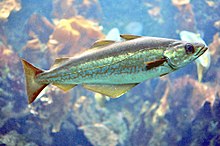Pollachius pollachius
| Atlantic pollock | |
|---|---|

| |
| Scientific classification | |
| Domain: | Eukaryota |
| Kingdom: | Animalia |
| Phylum: | Chordata |
| Class: | Actinopterygii |
| Order: | Gadiformes |
| Family: | Gadidae |
| Genus: | Pollachius |
| Species: | P. pollachius |
| Binomial name | |
| Pollachius pollachius (Linnaeus, 1758) | |
| Synonyms | |
|
Gadus pollachius Linnaeus, 1758 | |
Pollachius pollachius is a species of marine fish in the family Gadidae. FAO uses the English name pollack for this species, whereas in American English it is known as European pollock. Other vernacular names include lythe, and in the Isle of Man, calig.[2]
It is common in the north-eastern parts of the Northern Atlantic, including the Bay of Biscay and North Sea.[1] Adults can grow up to 130 cm (51 in) and weigh up to 12.5 kg (28 lb), although more commonly their maximum length is 75 cm (30 in).[2][3]
Ecology and life history
Pollack are fast-growing and relatively short-lived.[3] The maximum reported age is 15 years.[4] They are said to spawn offshore, although their spawning grounds are poorly known; a study of a fjord population in Norway suggested local spawning.[5]
Pollack are benthopelagic, that is, they live near the sea floor.[3] They seem to be relatively sedentary.[5][6]
Fisheries
Pollack is of value to fisheries, although it mainly represents bycatch. Landings data show three fairly distinct centres of distribution, one in the northern North Sea/Skagerrak extending north along the Norwegian coast, one between the English Channel, the Irish Sea, and the northern part of the French west coast, and one in the Iberian waters.[4] Total reported landings are of the order of a few thousand tonnes.[7]
Pollack is an important species in recreational fisheries. In Norway, tourist fishers alone were estimated to catch 100 tonnes of pollack in 2009.[8] In France, 3,500 tonnes of pollock were estimated to be caught in all recreational fisheries.[9]
References
- ^ a b Cook, R.; Fernandes, P.; Florin, A.; Lorance, P.; Nedreaas, K. (2014). "Pollachius pollachius". IUCN Red List of Threatened Species. 2014: e.T18125103A45098355. doi:10.2305/IUCN.UK.2014-3.RLTS.T18125103A45098355.en. Retrieved 17 February 2023.
- ^ a b Froese, Rainer; Pauly, Daniel (eds.). "Pollachius pollachius". FishBase. August 2022 version.
- ^ a b c Cohen, Daniel M.; Tadashi Inada; Tomio lwamoto; Nadia Scialabba (1990). FAO species catalogue. Vol. 10. Gadiform fishes of the world (Order Gadiformes). An annotated and illustrated catalogue of cods, hakes, grenadiers and other gadiform fishes known to date. FAO Fisheries Synopsis. Rome: FAO. p. 442.
- ^ a b ICES (May 2021). Stock Annex: Pollack (Pollachius pollachius) in Subarea 4 and Division 3.a (North Sea, Skagerrak and Kattegat). ICES Stock Annex. Copenhagen: International Council for the Exploration of the Sea. 4 pp.
- ^ a b Heino, M.; Svasand, T.; Nordeide, J. T.; Ottera, H. (2012). "Seasonal dynamics of growth and mortality suggest contrasting population structure and ecology for cod, pollack, and saithe in a Norwegian fjord" (PDF). ICES Journal of Marine Science. 69 (4): 537–546. doi:10.1093/icesjms/fss043.
- ^ Jakobsen, Tore (1985). Tagging of pollack on the Norwegian west coast in 1979 (Report). ICES Document. Copenhagen: ICES. 3 pp. CM 1985/G: 24.
- ^ "Global capture production Quantity (1950 - 2020)". FAO Fisheries and Aquaculture Department. Retrieved 17 February 2023.
- ^ Volstad, J. H.; Korsbrekke, K.; Nedreaas, K. H.; Nilsen, M.; Nilsson, G. N.; Pennington, M.; Subbey, S.; Wienerroither, R. (2011). "Probability-based surveying using self-sampling to estimate catch and effort in Norway's coastal tourist fishery". ICES Journal of Marine Science. 68 (8): 1785–1791. doi:10.1093/icesjms/fsr077. hdl:11250/108965.
- ^ ICES (2010). Report of the Planning Group on Recreational Fisheries (PGRFS), 7-11 June 2010, Bergen, Norway (PDF). ICES Document. Copenhagen: International Council for the Exploration of the Sea. 168 pp. CM 2010/ACOM:34.
External links
![]() Media related to Pollachius pollachius at Wikimedia Commons
Media related to Pollachius pollachius at Wikimedia Commons


